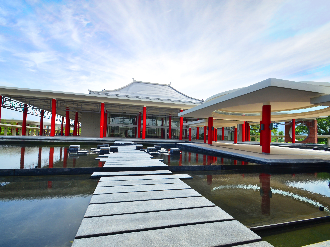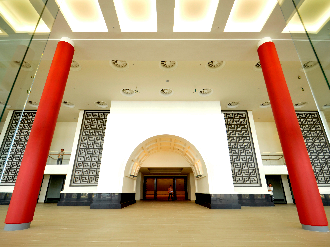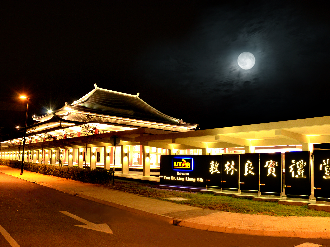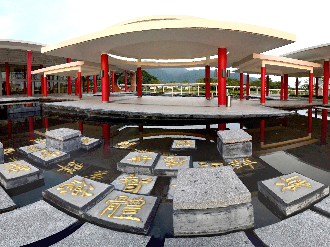

Dewan Tun Dr Ling Liong Sik

Built on a 12,000-square-metre plot west of a lake in
Kampar Campus, the 32.5-metre tall Dewan Tun Dr Ling Liong Sik is an icon that
stands out among other structures in UTAR Kampar Campus. It was named after the
illustrious founding father of Universiti Tunku Abdul Rahman (UTAR), Tun Dr Ling
Liong Sik, who is known and revered for his unflinching vision, wisdom,
passion, and tenacity in spearheading the setting up of this university that
has substantively touched the lives of countless many.
Dewan Tun Dr Ling Liong Sik is an imposing structure, a palatial hall built to commemorate the 10th anniversary of UTAR. This grand hall at UTAR Kampar Campus stands apart from the surrounding like a grand dame of a building complex - an inspiration by day and a gleaming beacon by night.
With double-eave roof and open space defined by red colonnades, the imposing hall is reminiscent of ancient Chinese grand halls with an outstanding feature of monumental Chinese architecture. Surrounding the hall on three sides is a 408-metre long roofed walkway which is part of a network of footpaths that serves as a circulation vessel of the campus.
As you approach the stately hall, you are greeted by a roofed driveway that leads to an inviting reception pavilion with round dome ceiling and square floor, symbolising heaven and earth or “Tian Yuan Di Fang 天圆地方”, while the pillars symbolise humans on earth. The overall structure of the round dome ceiling, square floor and pillars symbolises the balance and harmony between humans and nature or "Tian Ren He Yi 天人合一".
Flanking the pavilion are pools of water with dark floors representing the traditional Chinese inkwells that are used to dip the brush for Chinese painting and calligraphy. Bridging each ink pool is a paver slab with protruding blocks on both sides. These protruding blocks are the ink blocks that are emblazoned with Chinese characters, each block representing one of the Six Educational Pillars of UTAR education:
- Virtue and Morality 德
- Knowledge and
Intellect 智
- Physical and Mental
Health 体
- Sociality and
Humanitarianism 群
- Aesthetics and
Harmony 美
- Creativity and Innovation 新
These ink blocks with Chinese characters are symbolic reminders to all who pass through this grand hall that UTAR graduates are educated with wholesome universal values associated with its Six Educational Pillars.
This overall landscape feature in front of the hall was inspired by an ancient Chinese invention, the matrix printing, and it symbolises knowledge preservation and dissemination at UTAR to promote harmony and mutual understanding among local and global communities.
An integral part of the architectural design of the hall are two full-moon windows at two corners of the hall’s main entrance which afford framed views of the scenery of mountains, scenic lakes and other buildings of the campus.
As you walk past the concourse at the entrance and enter a grand foyer, you see an imposing four-leaf door with golden studs. This door opens to a majestic hall with two tiers of seats adequate for 3,500 persons.
This colossal Dewan Tun Dr Ling Liong Sik is irrefutably a hallmark of UTAR’s legacy that heralds the glorious years of empowering and inspirational educational excellence. This massive hall is now a paramount host to the congregations of graduands for convocations, meeting of bright minds to discuss ideas, gatherings of talents to showcase their work and performances, assemblies of scholars to present their research and creative endeavours, and many other get-togethers.









